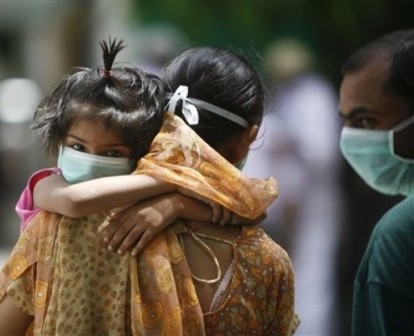- Malaria is a life-threatening disease caused by parasites that are transmitted to people through the bites of infected mosquitoes.
- A child dies of malaria every 30 seconds.
- There were 247 million cases of malaria in 2006, causing nearly one million deaths, mostly among African children.
- Malaria is preventable and curable.
- Approximately half of the world's population is at risk of malaria, particularly those living in lower-income countries.
- Travellers from malaria-free areas to disease "hot spots" are especially vulnerable to the disease.Malaria takes an economic toll - cutting economic growth rates by as much as 1.3% in countries with high disease rates.


Malaria is caused by parasites of the species Plasmodium. The parasites are spread to people through the bites of infected mosquitoes.
There are four types of human malaria:
Plasmodium falciparum
Plasmodium vivax
Plasmodium malariae
Plasmodium ovale.
Plasmodium falciparum and Plasmodium vivax are the most common. Plasmodium falciparum is the most deadly.
Common symptoms of malaria
In the early stages, malaria symptoms are sometimes similar to those of many other infections caused by bacteria, viruses, or parasites. Symptoms may include:
Fever.
Chills.
Headache.
Sweats.
Fatigue.
Nausea and vomiting.
Other common symptoms of malaria include:
Dry (nonproductive) cough.
Muscle and/or back pain.
Enlarged Spleen
Complications of Malaria( Falciparum):
Cerebral malaria
Algid Malaria
ARDS
Convulsion
Coma
Acute Renal Failure
Hypoglycemia
hyperthermia
hyperparasitemia
severe anemia
Symptomatic diagnosis
Using Giemsa-stained blood smears from children in Malawi, one study showed that when clinical predictors (rectal temperature, nailbed pallor, and splenomegaly) were used as treatment indications, rather than using only a history of subjective fevers, a correct diagnosis increased from 21% to 41% of cases and unnecessary treatment for malaria was significantly decreased.
Microscopic examination of blood films
Field tests
In areas where microscopy is not available, or where laboratory staff are not experienced at malaria diagnosis, there are antigen detection tests that require only a drop of blood. Immunochromatographic tests (also called: Malaria Rapid Diagnostic Tests, Antigen-Capture Assay or "Dipsticks") have been developed, distributed and fieldtested. These tests use finger-stick or venous blood, the completed test takes a total of 15–20 minutes, and a laboratory is not needed. The threshold of detection by these rapid diagnostic tests is in the range of 100 parasites/µl of blood compared to 5 by thick film microscopy. The first rapid diagnostic tests were using P. falciparum glutamate dehydrogenase as antigen.[42] PGluDH was soon replaced by P.falciparum lactate dehydrogenase, a 33 kDa oxidoreductase [EC 1.1.1.27]. It is the last enzyme of the glycolytic pathway, essential for ATP generation and one of the most abundant enzymes expressed by P.falciparum. PLDH does not persist in the blood but clears about the same time as the parasites following successful treatment. The lack of antigen persistence after treatment makes the pLDH test useful in predicting treatment failure. In this respect, pLDH is similar to pGluDH. The OptiMAL-IT assay can distinguish between P. falciparum and P. vivax because of antigenic differences between their pLDH isoenzymes. OptiMAL-IT will reliably detect falciparum down to 0.01% parasitemia and non-falciparum down to 0.1%. Paracheck-Pf will detect parasitemias down to 0.002% but will not distinguish between falciparum and non-falciparum malaria. Parasite nucleic acids are detected using polymerase chain reaction. This technique is more accurate than microscopy. However, it is expensive, and requires a specialized laboratory. Moreover, levels of parasitemia are not necessarily correlative with the progression of disease, particularly when the parasite is able to adhere to blood vessel walls. Therefore more sensitive, low-tech diagnosis tools need to be developed in order to detect low levels of parasitaemia in the field. Areas that cannot afford even simple laboratory diagnostic tests often use only a history of subjective fever as the indication to treat for malaria. Using Giemsa-stained blood smears from children in Malawi, one study showed that unnecessary treatment for malaria was significantly decreased when clinical predictors (rectal temperature, nailbed pallor, and splenomegaly) were used as treatment indications, rather than the current national policy of using only a history of subjective fevers (sensitivity increased from 21% to 41%).
Molecular methods
Molecular methods are available in some clinical laboratories and rapid real-time assays (for example, QT-NASBA based on the polymerase chain reaction) are being developed with the hope of being able to deploy them in endemic areas.
Rapid antigen tests
OptiMAL-IT will reliably detect falciparum down to 0.01% parasitemia and non-falciparum down to 0.1%. Paracheck-Pf will detect parasitemias down to 0.002% but will not distinguish between falciparum and non-falciparum malaria. Parasite nucleic acids are detected using polymerase chain reaction. This technique is more accurate than microscopy. However, it is expensive, and requires a specialized laboratory. Moreover, levels of parasitemia are not necessarily correlative with the progression of disease, particularly when the parasite is able to adhere to blood vessel walls. Therefore more sensitive, low-tech diagnosis tools need to be developed in order to detect low levels of parasitaemia in the field.

























